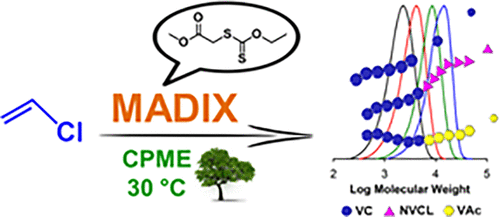当前位置:
X-MOL 学术
›
Macromolecules
›
论文详情
Our official English website, www.x-mol.net, welcomes your feedback! (Note: you will need to create a separate account there.)
Polymerization of Vinyl Chloride at Ambient Temperature Using Macromolecular Design via the Interchange of Xanthate: Kinetic and Computational Studies
Macromolecules ( IF 5.5 ) Pub Date : 2019-12-24 , DOI: 10.1021/acs.macromol.9b01949 Carlos M. R. Abreu 1 , Talita C. Rezende 1 , Ana C. Fonseca 1 , Tamaz Guliashvili 2 , Cédric Bergerbit 3 , Franck D’Agosto 3 , Li-Juan Yu 4 , Arménio C. Serra 1 , Michelle L. Coote 4 , Jorge F. J. Coelho 1
Macromolecules ( IF 5.5 ) Pub Date : 2019-12-24 , DOI: 10.1021/acs.macromol.9b01949 Carlos M. R. Abreu 1 , Talita C. Rezende 1 , Ana C. Fonseca 1 , Tamaz Guliashvili 2 , Cédric Bergerbit 3 , Franck D’Agosto 3 , Li-Juan Yu 4 , Arménio C. Serra 1 , Michelle L. Coote 4 , Jorge F. J. Coelho 1
Affiliation

|
Reversible deactivation radical polymerization of vinyl chloride (VC) by methyl (ethoxycarbonothioyl)sulfanyl acetate (MEA)-mediated macromolecular design via the interchange of xanthate (MADIX) polymerization at ambient temperature is reported. The polymerization system was studied using two conventional radical initiators (having very distinct half-life times at room temperature). The system was optimized regarding the nature of the solvent, the monomer concentration, the polymerization temperature, and the target molecular weight. The kinetic data showed linear first-order kinetics, the linear evolution of molecular weights with conversion, and polymers with narrow molecular weight distributions (Đ ≈ 1.2 to 1.3) using a low temperature (30–42 °C) and cyclopentyl methyl ether (CPME) as a “green” solvent. The resulting MEA-terminated poly(vinyl chloride) (PVC) was fully characterized by 1H nuclear magnetic resonance spectroscopy that revealed the existence of a very small fraction of structural defects and the presence of chain-end functional groups. “One-pot” chain extension (with VC) and “one-pot” block copolymerizations (with vinyl acetate − VAc and N-vinylcaprolactam − NVCL) experiments confirmed the “livingness” of the MEA-terminated PVC chains, giving access to different PVC-based block copolymers. Computational studies confirm the results of the solvent screen and suggest that changes to the initial MADIX leaving or stabilizing groups could improve control. The computational data were further confirmed using methyl 2-(4-methoxyphenoxycarbonothioylthio)acetate. This work establishes a new green route to afford a wide range of new complex macrostructures including high-value materials based on PVC segments.
中文翻译:

通过黄原酸酯交换的大分子设计在室温下聚合氯乙烯的动力学和计算研究
据报道,在室温下,通过黄原酸酯(MADIX)聚合反应的交换,通过甲基(乙氧基碳硫代酰基)硫代乙酸乙酸酯(MEA)介导的大分子设计可逆的氯乙烯(VC)的自由基失活自由基聚合。使用两种常规的自由基引发剂(在室温下具有非常不同的半衰期)对聚合体系进行了研究。针对溶剂的性质,单体浓度,聚合温度和目标分子量对系统进行了优化。动力学数据显示线性一阶动力学,分子量随转化率线性演变以及分子量分布窄的聚合物(Đ≈1.2至1.3),使用低温(30–42°C)和环戊基甲基醚(CPME)作为“绿色”溶剂。所得的MEA端接的聚氯乙烯(PVC)通过1 H核磁共振波谱进行了充分表征,该波谱揭示了非常少部分的结构缺陷和链端官能团的存在。“一锅”扩链(带有VC)和“一锅”嵌段共聚(带有醋酸乙烯酯-VAc和N-乙烯基己内酰胺-NVCL)实验证实了MEA封端的PVC链的“活性”,可以使用不同的基于PVC的嵌段共聚物。计算研究证实了溶剂筛选的结果,并建议更改初始MADIX离开或稳定基团可以改善控制效果。使用2-(4-甲氧基苯氧基碳硫代硫基硫代)乙酸甲酯进一步证实了计算数据。这项工作建立了一条新的绿色路线,以提供各种新型复杂的宏观结构,包括基于PVC片段的高价值材料。
更新日期:2019-12-25
中文翻译:

通过黄原酸酯交换的大分子设计在室温下聚合氯乙烯的动力学和计算研究
据报道,在室温下,通过黄原酸酯(MADIX)聚合反应的交换,通过甲基(乙氧基碳硫代酰基)硫代乙酸乙酸酯(MEA)介导的大分子设计可逆的氯乙烯(VC)的自由基失活自由基聚合。使用两种常规的自由基引发剂(在室温下具有非常不同的半衰期)对聚合体系进行了研究。针对溶剂的性质,单体浓度,聚合温度和目标分子量对系统进行了优化。动力学数据显示线性一阶动力学,分子量随转化率线性演变以及分子量分布窄的聚合物(Đ≈1.2至1.3),使用低温(30–42°C)和环戊基甲基醚(CPME)作为“绿色”溶剂。所得的MEA端接的聚氯乙烯(PVC)通过1 H核磁共振波谱进行了充分表征,该波谱揭示了非常少部分的结构缺陷和链端官能团的存在。“一锅”扩链(带有VC)和“一锅”嵌段共聚(带有醋酸乙烯酯-VAc和N-乙烯基己内酰胺-NVCL)实验证实了MEA封端的PVC链的“活性”,可以使用不同的基于PVC的嵌段共聚物。计算研究证实了溶剂筛选的结果,并建议更改初始MADIX离开或稳定基团可以改善控制效果。使用2-(4-甲氧基苯氧基碳硫代硫基硫代)乙酸甲酯进一步证实了计算数据。这项工作建立了一条新的绿色路线,以提供各种新型复杂的宏观结构,包括基于PVC片段的高价值材料。



























 京公网安备 11010802027423号
京公网安备 11010802027423号